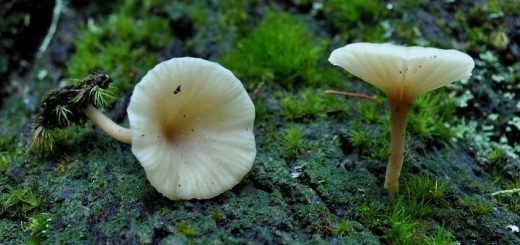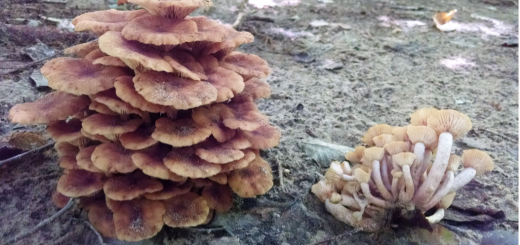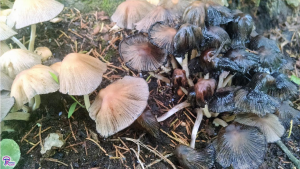#034: Mushroom Morphology: False Morels
False Morels, despite their name, are easily distinguished from true morels simply by simply looking at them. If you are new to identifying false morels, there are three factors that set them apart from true morels: 1) false morels have a head that is wrinkled, rather than consisting of ridges and pits; 2) false morels have a head that is attached only at the top of the stipe; 3) and false morels have a stipe that is solid or filled with cottony material, rather than hollow. If you’re unsure whether you have a false or a true morel, just slice the mushroom from top to bottom and look for the three factors above. If you’re familiar with these two groups of mushrooms, then you can differentiate between them just by glancing at them. I think that false morels look kind of like melted versions of morels: instead of the upright head of a true morel, false morels have heads that are flopped over and lopsided, as if they had melted in the sun. False morels appear in the early spring, often in the same areas as true morels. In fact, the two groups of mushrooms can frequently be found fruiting relatively close together.
All false morels contain the toxin gyromitrin and should be treated as poisonous. Despite this, some false morels like Gyromitra esculenta have been eaten (especially in Europe) for a long time. Gyromitrin is a volatile compound and can be removed from the mushroom by boiling, allowing the mushroom to be eaten. However, there can still be some gyromitrin left in the mushroom, which may accumulate in your body over time. You can also become poisoned by the vapor from boiling the mushroom, which contains significant amounts of gyromitrin. Different patches of false morels have different concentrations of gyromitrin, so edibility of false morels varies by region. Despite this, I recommend against eating any false morel. The onset of symptoms of gyromitrin poisoning is delayed by 6 to 12 hours and can include: “nausea, vomiting, diarrhea, cramps, distention, weakness, lassitude, and headache; if the condition is severe, these may develop into jaundice, convulsions, coma, and death.”* Gyromitrin is also a carcinogen, so long-term exposure may raise the risk of cancer.
All false morels are contained in the genus Gyromitra. This genus is found in the Phylum Ascomycota, Class Pezizomycetes, Order Pezizales, and Family Discinaceae. Gyromitra species come in a variety of other shapes, but they are all variations on the basic false morel morphology. They all have a wrinkled head and a solid or cottony stipe, although in some the stipe is greatly reduced. Some Gyromitra species end up looking more like cups. Careful macroscopic observation is usually enough to separate species of Gyromitra, although microscopic analysis of the spores is sometimes required.
See Further:
* more details on gyromitrin: http://botit.botany.wisc.edu/toms_fungi/may2002.html
http://www.mushroomexpert.com/gyromitra.html
http://www.mushroomexpert.com/taxonomy.html
See FFF#033 for more on true morels.









![#011: Characteristics of Kingdom Fungi [Archived]](https://www.fungusfactfriday.com/wp-content/themes/hueman/assets/front/img/thumb-small-empty.png)


10 Responses
[…] morels and poisonous false morels. Don’t worry; it’s really not as hard as it sounds. See FFF#034 for more on false […]
[…] These odd-looking ascomycete mushrooms are all found in the genus Helvella. The mushrooms have a smooth to highly wrinkled stipe and a head that is cup-shaped to saddle-shaped to lobed to irregular. Some elfin saddles have a small stipe and look like large cup mushrooms but have ribs that extend up the stipe and onto the base of the cup. Other elfin saddles with cup-shaped heads have long stipes but are smooth. There are also some with heads that really do look like a saddle for a horse. Elvin saddles with lobed or irregular heads often have large, fluted (wrinkled to grooved) stipes. Sometimes the stipes are so deeply grooved that there are holes going completely through the stipe. I like to think of these mushrooms as mushroom ghosts. To me, they look like shriveled-up, ghost versions of false morels. Most elfin saddles come in various shades of brown, but there are also a few that are black. More highly-colored mushrooms that look like elfin saddles are probably in the in the genus Gyromitra (false morels). […]
[…] Next story #034: Mushroom Morphology: False Morels […]
[…] “Carolina False Morel,” or – my personal favorite – “Big Red,” is a false morel (see FFF#034) that can grow to astounding sizes. It has a reddish-brown cap that is tightly wrinkled, making it […]
[…] morels (FFF#034) are typically brownish and have less well-defined ridges. These should be easy to distinguish, […]
[…] are also somewhat similar to false morels (FFF#034) and elfin saddles (FFF#035), which also have caps that attach only to the top of the stipe. […]
[…] Although they are irregular, the ridges and pits are well-defined, unlike most false morels (FFF#034), which have smaller “ridges” that are more like wrinkles. Additionally, morels have a single […]
[…] you just can’t figure out which species yours is, it’s OK. There are also a few false morels (FFF#0344) and verpas (FFF#067) that beginners can confuse with Yellow Morels. These can easily be […]
[…] are a number of morel look-alikes, including verpas (FFF#067) and false morels (FFF#034). Verpas are closely related to morels and look very similar to morels. The distinguishing […]
[…] brunnea is a false morel (see FFF#034) that is fairly common in the eastern and midwestern parts of North America. Like the other false […]